Portugal’s hilly capital, the coastal city of Lisbon is the westernmost capital of Europe. Colourful and historic, the city is teeming with life in every corner, and every person and structure has a story to tell that will reveal secrets to the lively Portuguese culture and the monuments of Lisbon makes it more attractive. Lisbon’s culture and history mix with contemporary urban life and cosmopolitan nature in a unique way to produce one of the most interesting experiences across Western Europe.The city has colour busting out of every turn, made even more quaint with its cobblestone streets. The hill of Lisbon is topped off with the beautiful San Jorge Castle, displaying elegant European architecture, a sign of pride to all the residents of the city. Belem Tower and Jeronimos Monastery are other fine examples of the marvellous architecture that can be found all over the city. The National Azulejo Museum and the Calouste Gulbenkian Museum complex are perfect to witness the evolution of Portuguese history, culture and art. It is also the city where you can hear the best of Fado music. One thing you cannot miss out on in this city is the mouthwatering range of food, specifically seafood. You should definitely visit following top 10 monuments in Lisbon:
List of Monuments in Lisbon
1. The Tower of Belem
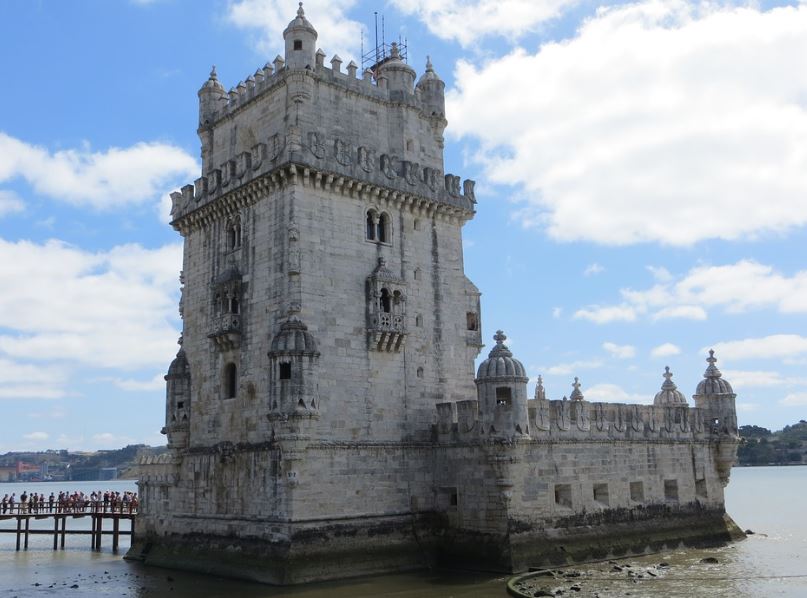
The Torre de Belem (Belem Tower), Lisbon The Torre de Belem is the most popular monument in Lisbon Potugal. This delightful little fort guarded the Tejo Estuary since the 16th century and was constructed at the height of the Manueline style of architecture. Decorating the fort are Arabic styled watchtowers, battlements adorned with the “Cross of Christ” and the earliest carving of a rhinoceros in Europe.Being the icon of Lisbon, the Torre de Belem is always popular with tourists, and there can be very long queues to visit the rather empty and austere interior of the fort. The true beauty of the Torre de Belem is the highly ornate exterior, which is best seen from the landside or via a boat tour. This article will provide a tourist guide to the Torre de Belem. The real attraction of the Torre de Belem is the exterior stone carving, inside is a little sparse. There are good views from the top floor of the fort, but the view from the Padrão dos Descobrimentos monument is much better.
Address: Torre de Belem, Lisbon, Portugal.
Read More: Guide to Reach Belem Tower From Lisbon
2. Estação do Rossio

Estação do Rossio
Designed by architect José Luís Monteiro in the late 19th century, the Rossio train station reflects the typical Portuguese Neo-Manueline architecture, which was popular in the middle of the 19th and beginning of the 20th century. The Estação do Rossio may not receive as many travellers as the Oriente Station, but it attracts plenty of design-interested visitors who come to gaze at the splendidly designed stone arches, beautiful clock tower and lofty ceiling inside. This historical landmark in Lisbon is also the one to leave from when travelling to Sintra, one of Europe’s loveliest cities.
Address: 125 Rua 1º de Dezembro, Lisboa, Lisboa, 1249-970, Portugal.
3. Castelo de São Jorge
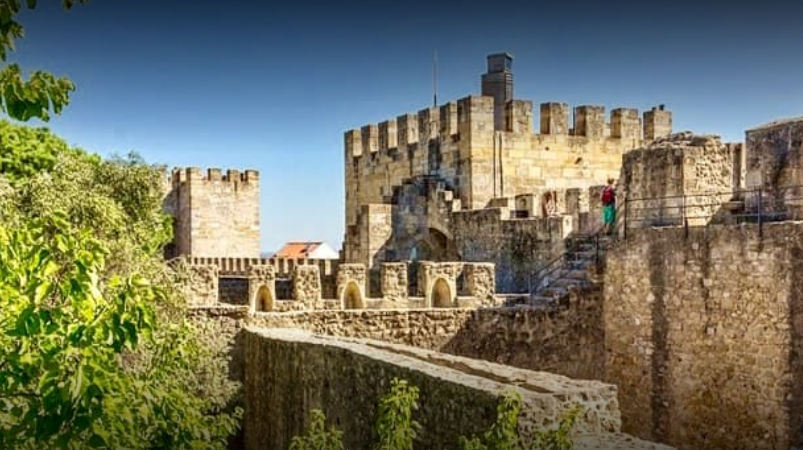
Castelo de São Jorge
The Castelo de São Jorge castle stands majestically above central Lisbon and was entwined in the early history of Portugal. It was here that the Christian crusaders defeated the Moors in 1147, the Portuguese survived a siege by Castile (1373) and was the seat of power for Portugal for over 400 years.This rich and extensive history of this famous monument in Lisbon is captured within the castle, from the formidable fortifications, the defensive viewpoints or the tranquil gardens of the royal quarters. For visitors there is a lot to experience while in the castle, the citadel’s towers and battlements can be explored, there are amazing views over the city, along with an informative museum. The castle is in the heart of the Alfama district, one of the most characterful areas of Lisbon, and is where we recommend you begin your tour of Lisbon.
Address: R. de Santa Cruz do Castelo, 1100-129 Lisboa, Portugal.
Read More: Monuments in Beijing China
4. Elevador de Santa Justa
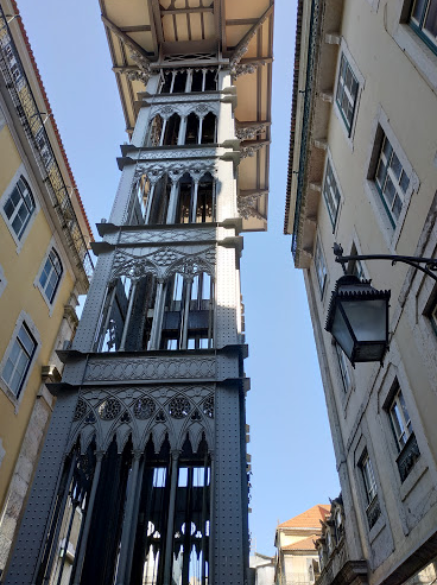
Elevador de Santa Justa
The Elevador de Santa Justa is an industrial age lift, which transports passengers up one of the steepest hills in central Lisbon. The lift was constructed in an era when artistic detail and flare were incorporated into the magnificent machines that powered the age. Within the iron, structures are gothic arches and geometric patterns, while the cabins are lined with polished wood and controlled by brass dials. The Elevador de Santa Justa is a truly unique landmark in Lisbon and saves having to climb one of the city’s steepest hills. The terrace at the top of the lift provides wonderful views over central Lisbon and is a very romantic location at night. The entrance cost is €5.30 return (including viewpoint) – €1.50 viewing platform entrance.
Address: R. do Ouro, 1150-060 Lisboa, Portugal.
5. Cristo Rei Statue

Cristo Rei Statue
The Cristo Rei statue towers above the southern banks of the Tejo Estuary and is one of the most popular monuments in Lisbon. This statue has many similarities to the Christ the Redeemer statue in Rio de Janeiro, and this is true as the Brazilian monument inspired the Portuguese statue. Apart from being a distinctive landmark, the Cristo Rei statue provides one of the best viewpoints of Lisbon, with unrivalled views of the suspension bridge and city. By public transport, the statue can be easily and inexpensively travelled; there is a ferry from Cais do Sodré to Cacilhas and then by bus from Cacilhas to the Cristo Rei statue. The ferry ride is an enjoyable activity. The charges for visiting this monument are as; Cacilhas ferry is €1.30 for single, 101 bus €1.45, Elevator of Boca do Vento free, Cristo Rei viewing platform €6.00.
Address: Cristo Rei statue, Lisbon, Portugal.
6. São Roque Church
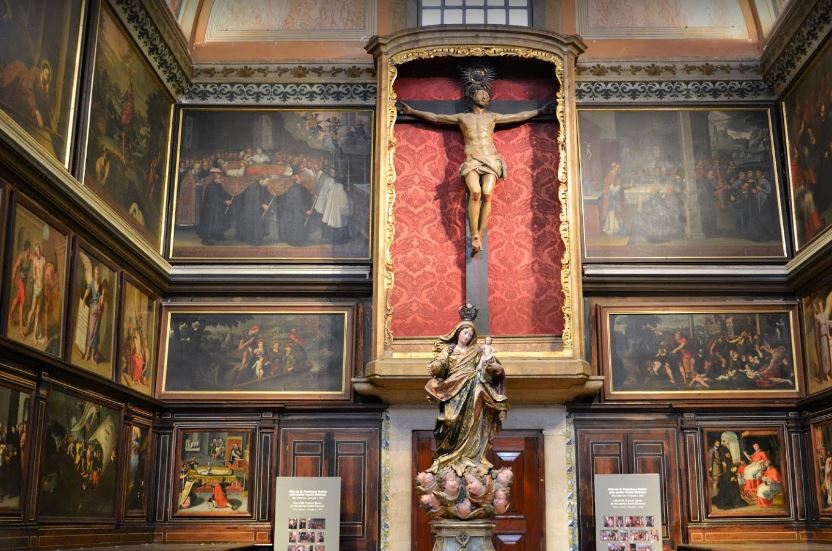
São Roque Church
When you gaze at the exterior of the São Roque Church in Bairro Alto, it’s hard to imagine that the plain, white facade conceals the most beautiful cathedral in Lisbon. The religious monument in Lisbon was constructed in intervals, and one chapel, Capela de São João Baptista, was designed in Rome and transported to Lisbon where it was assembled. The first Jesuit church built in Portugal, the São Roque Church features lots of giltwood, detailed mosaics and a stunning painted ceiling. Next door, you’ll find the Museum of São Roque, among the most complete museums of Portuguese religious art.
Address: São Roque Church, Lisbon Portugal.
Don’t Miss: Most Visited Monuments in Rio de Janeiro
7. National Pantheon
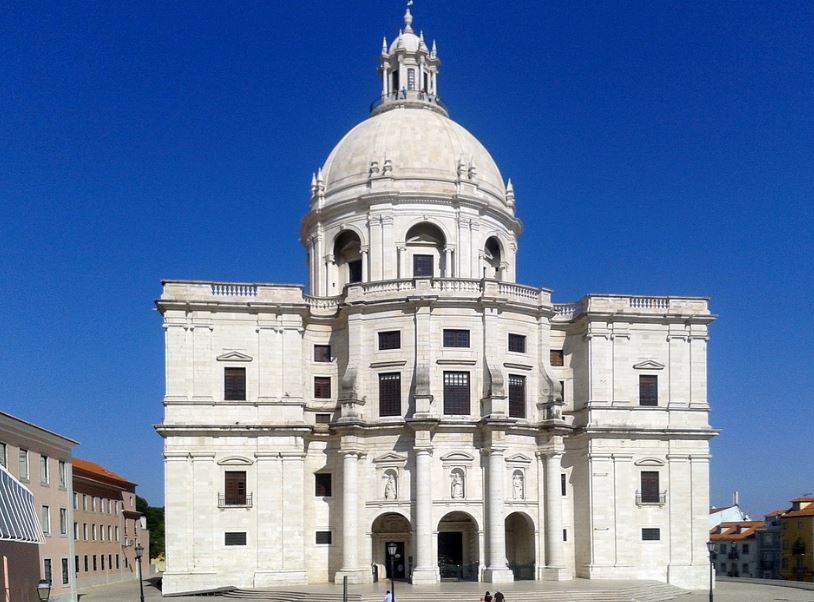
National Pantheon
A symbol of Portuguese identity, the National Pantheon is a national monument in Lisbon that welcomes and honors the great men and women to whom the country owes its recognition. A memory that perpetuates and symbolizes the highest posthumous honor granted in Portugal. The history of the National Pantheon features curious facts about its tumultuous construction process, which is the result of many historical contingencies experienced by the country over a period of nearly 300 years. The National Pantheon’s architecture is a unique example of Baroque in Portugal. In order to build it, the architect João Antunes was inspired by Italian trends, thus adopting an innovative architectural design that had no continuity in Portugal. Be sure to enjoy the details on the National Pantheon’s undulating walls, as well as the rich decor with colored marble and inlaid stone. We must also highlight the monumental dome that rises about 80 meters above ground. We suggest you visit the National Pantheon with time to spare, in order to be able to admire all its historical facts and architectural details. A visit to the National Pantheon is indispensable, not only because of the architectural and historical features but for all the symbolism it represents in Portugal’s history.
Address: Campo de Santa Clara, 1100-471 Lisboa, Portugal.
8. Lisbon Cathedral
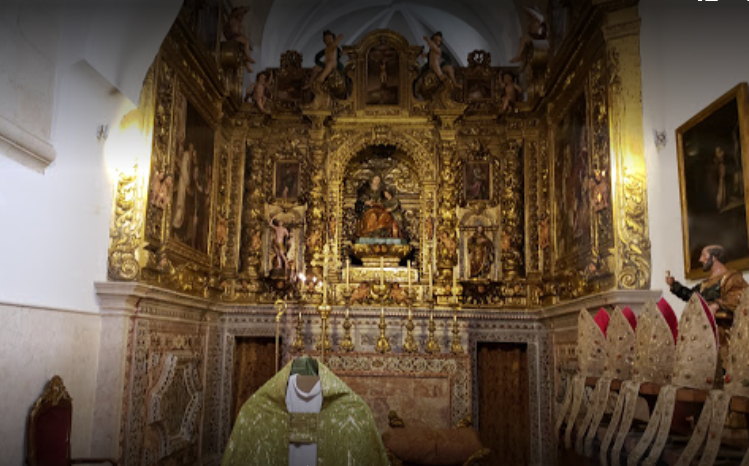
Lisbon Cathedral
Lisbon’s Cathedral was constructed by D. Afonso Henriques, three years after the conquest of Lisbon. This cathedral was built over the old Muslim mosque. In its interior the cathedral has three naves, with six spans and presents a dark austere style. The most valious piece present in the cathedral is an ark which contains the remains of Saint Vicent, which were transported from Saint Vicent’s Cape to Lisbon. In the interior of this old monument in Lisbon you might also observe remains of old Roman ruins. According to the legend, two crows escorted the boat in which the Saint Vicent’s remain came in. This is also the reason why crows and the boat have become one of Lisbon’s symbols.
Address: Lisbon Cathedral, Lisbon, Portugal.
9. Vasco da Gama Bridge

Vasco da gama Bridge
The Vasco da Gama bridge connects Lisbon to Montijo and Alcochete and starts near Parque das Nações. This must see monument in Lisbon was inaugurated in 1998 and it’s the longest bridge in Europe and the 9th widest bridge in the world with more than 17 kilometers, 12 above water. As a celebration of the 500 years of the arrival of Vasco da Gama to India (in 1498), the bridge was named after him and its inauguration was commemorated with a portuguese typical dish – feijoada – served on a table with the same length as the bridge, this meal’s recorded in the Guinness World Records.
Address: PTE Vasco da Gama, Lisboa, Portugal.
Don’t Miss: Most Visited Monuments in Venice
10. Praça do Comércio
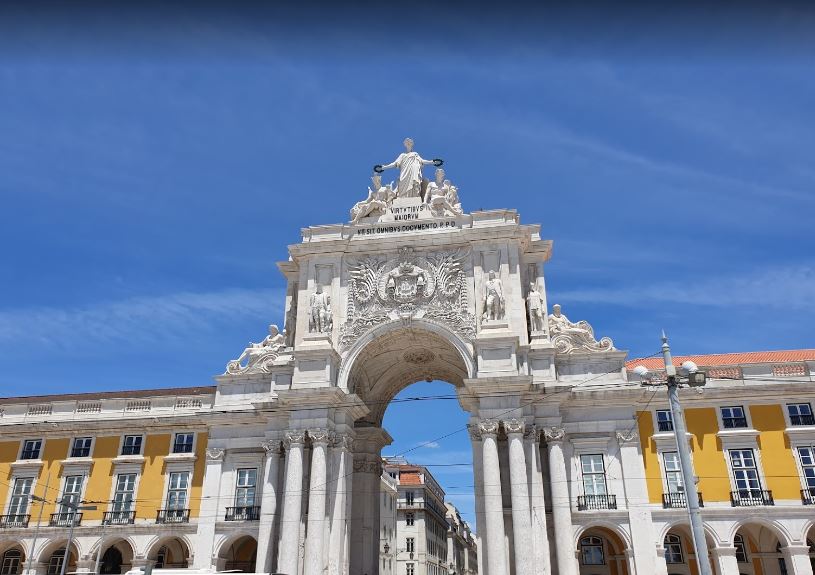
Praça do Comércio
The Praça do Comércio is the most magnificent plaza in Lisbon and was historically the commercial hub of the city. In the plaza, merchants would trade exotic items and spices, and explorers would seek financing for voyages to Africa, India or Brazil. Today this important landmark in Lisbon is just as lively, but the focus is tourism and culture. Residing in the distinctive yellow buildings are sophisticated restaurants and boutique hotels and there is always a great (holiday) atmosphere about the plaza. The Arco da Rua Augusta is the triumphal arch, which leads from the Praça do Comércio into central Lisbon, and at the top of the monument is a wonderful panoramic viewing point.
Address: Praça do Comércio, Lisbon, Portugal.
11. Padrão dos Descobrimentos

Padrão dos Descobrimentos
The Padrão dos Descobrimentos commemorates the Portuguese explorers of the 15 and 16th-century. This bold and powerful monument stands on the banks of the Tejo Estuary, and was where many of these voyages to India and Brazil departed from. Along two sides of the Padrão dos Descobrimentos are lifelike depictions of the explorers and the prominent people from the era, who funded or supported the voyages. At the top of the monument is a viewing terrace, which provides outstanding views of the Belem district. You must visit this iconic monument in Lisbon and best to go in the afternoon and it is near to the Tower of Belém.
Address: Padrão dos Descobrimentos, Lisbon, Portugal.
12. Oriente Station

Oriente Station
The bright white Oriente Station is the main entrance and exit for travellers heading in and out of Lisbon by train or bus and is known locally as the Gare do Oriente. The maritime theme of Expo ’98 is mirrored in the station’s wave-like beams at the entrance, and the building itself is an interesting mix of Gothic architecture and modernism. The juxtaposition between the Gothic concrete arches and the more futuristic latticework of the two-level station makes it worth the attention of architecture fans. At the ground level of this iconic landmark in Lisbon you’ll find the bus station, as well as cafés, banks and shops, while the bottom level is the entrance of the metro and home to small markets. Meanwhile, the upper level is for trains.
Address: Oriente Station, Labon, Portugal.
So far we have discussed the most visited monuments in Lisbon. I hope you might have gathered some information related to it. If you are planning your trip to Lisbon then kindly go through our other articles as well which will be quite beneficial for you. Please share your views regarding the content explained above and liked it too.
The post The 12 Famous Monuments in Lisbon Portugal | Most Visited Monuments in Lisbon appeared first on World Tour & Travel Guide, Get Travel Tips, Information, Discover Travel Destination | Adequate Travel.